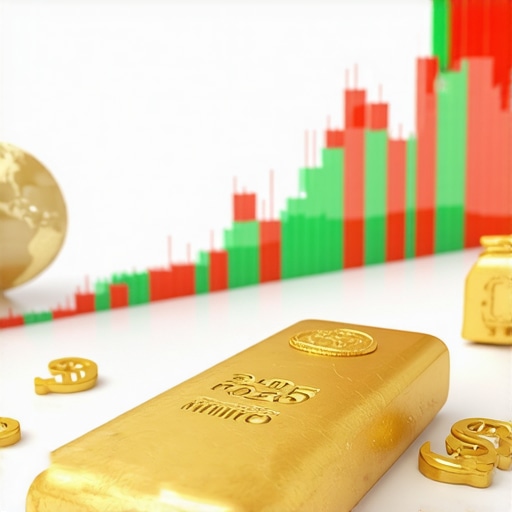Understanding the Strategic Role of Central Bank Gold Purchases in Global Markets
Central banks have long been pivotal actors in the gold market, not merely as custodians of national reserves but as strategic influencers of global demand dynamics. In recent years, the pattern of central bank gold acquisitions has evolved into a critical driver that shapes market sentiment, price trajectories, and international monetary confidence. This article dissects how these purchases mold the demand landscape for gold worldwide, highlighting nuanced mechanisms behind price elasticity, reserve diversification, and geopolitical signaling.
Deconstructing Central Bank Gold Buying: A Catalyst for Demand and Price Stability
Central bank gold buying activities contribute directly to the physical demand for gold, often offsetting fluctuations in private sector investment and jewelry consumption. Unlike speculative investors, central banks operate with a long-term horizon, acquiring gold to safeguard against currency volatility, inflationary pressures, and systemic financial risks. This institutional demand tends to exert a stabilizing influence on gold prices, mitigating excessive market volatility by absorbing large volumes of metal from the market.
How Do Central Bank Gold Purchases Influence Market Dynamics Beyond Price?
Beyond price effects, central bank gold acquisitions have profound implications on liquidity, supply chain logistics, and geopolitical trust. When central banks increase their gold reserves, they effectively reduce available supply, tightening market conditions. This scarcity can encourage private investors to view gold as a more attractive asset class, reinforcing upward demand momentum. Additionally, central bank buying often signals confidence in gold’s role as a monetary anchor, which can recalibrate investor expectations globally.
Reserve Diversification and Geopolitical Strategy: The Deeper Motivations Behind Purchases
Central banks diversify reserves to reduce reliance on dominant reserve currencies and to hedge against geopolitical uncertainties. Gold, with its intrinsic value and universal acceptance, becomes a strategic tool for preserving financial sovereignty. Countries facing economic sanctions or geopolitical tensions increasingly turn to gold purchases as a means to insulate their economies. These strategic imperatives elevate demand in specific regions, influencing global trade flows and investment patterns.
Technical Considerations: How Central Bank Behavior Affects Gold Supply and Demand Curves
The timing, volume, and frequency of central bank gold purchases can shift the supply-demand equilibrium, impacting futures markets and price forecasts. Large-scale acquisitions may trigger anticipatory buying among market participants, amplifying demand beyond the initial purchase. Conversely, central banks may also lend gold to stabilize markets temporarily, introducing complex feedback loops that sophisticated investors must analyze to optimize their strategies.
For a comprehensive understanding of these dynamics, investors can explore how central bank gold purchases impact market dynamics, which provides detailed insights into institutional buying patterns and their macroeconomic ramifications.
What Are the Emerging Trends in Central Bank Gold Buying That Investors Should Monitor in 2025?
In 2025, emerging trends include increased gold accumulation by emerging market central banks seeking to reduce dollar dependency, and renewed interest from developed economies aiming to hedge against inflationary pressures exacerbated by geopolitical conflicts. Additionally, digital gold instruments and evolving regulatory frameworks are influencing how central banks approach physical gold acquisitions. Monitoring these trends is crucial for investors aiming to align their portfolios with global demand shifts.
To deepen your expertise on analyzing gold demand trends and positioning for 2025, consider reading Analyzing Gold Demand Trends: What Investors Must Know in 2025.
Call to Action: Engage With Expert Analyses to Sharpen Your Gold Investment Strategy
Given the complexity and layered implications of central bank gold buying, investors and analysts are encouraged to explore specialized content on gold market mechanics. Delve into expert-level discussions and contribute your insights on how these institutional behaviors influence portfolio construction and risk management. Visit How Central Bank Gold Buying Shapes Demand Trends in 2025 to expand your strategic understanding and join a community of knowledgeable investors navigating the evolving gold landscape.
Source: World Gold Council, “Central Bank Gold Reserves Report 2024” – https://www.gold.org/goldhub/data/central-bank-reserves
Central Bank Gold Purchases and Market Sentiment: Beyond the Numbers
Central bank gold buying not only influences fundamental supply and demand but also profoundly shapes market sentiment. When central banks signal increased gold acquisitions, it often triggers a ripple effect across financial markets. Investors interpret these actions as a hedge against macroeconomic uncertainties such as inflation, currency devaluation, or geopolitical risks, thereby amplifying speculative demand in both physical and derivative gold markets. This psychological dimension reinforces gold’s safe-haven status, which can lead to price premiums that extend beyond tangible supply constraints.
How Can Investors Leverage Central Bank Gold Trends to Optimize Portfolio Resilience?
Expert investors analyze central bank gold buying patterns to anticipate shifts in global liquidity and risk appetite. By integrating data on reserve diversification and geopolitical developments, investors can position their portfolios to capture upside in gold prices while mitigating downside risks from currency fluctuations or market turmoil. Strategic allocation to physical gold, gold ETFs, or mining equities should consider the nuances of central bank behavior, including the timing and scale of purchases. For instance, increased buying by emerging market central banks may indicate a longer-term structural demand, suggesting a bullish stance on physical gold holdings.
For a detailed framework on constructing a resilient portfolio incorporating these insights, explore How to Build a Gold Investment Portfolio for Steady Returns.
The Intersection of Digital Gold Instruments and Central Bank Strategies
As digital asset platforms evolve, central banks face new considerations in how they manage gold reserves. While physical gold remains the cornerstone of reserves, digital gold tokens and blockchain-enabled ownership present opportunities and challenges. These instruments offer enhanced liquidity and transparency but also introduce regulatory and custodial complexities. Central banks must balance the reliability of physical bullion with the efficiency of digital assets, potentially influencing market demand and future gold price formation.
Understanding these technological shifts is crucial for investors aiming to anticipate market innovations that could alter traditional gold demand drivers.
According to the World Gold Council’s research on digital gold assets, the integration of digital platforms is expected to complement rather than replace physical gold, creating layered demand dynamics in forthcoming years.
Analyzing the Impact of Central Bank Gold Leasing on Market Liquidity
Central bank gold leasing, the practice of lending gold to bullion banks or traders, injects temporary supply into the market, affecting liquidity and price volatility. While leasing can stabilize short-term market imbalances, excessive leasing risks undermining perceived scarcity, potentially dampening price momentum. Investors should monitor leasing volumes and terms as indicators of central bank market interventions that may influence supply-demand equilibrium.
Integrating leasing data with purchase trends provides a comprehensive view of central bank influence, empowering investors to refine timing and instrument selection in gold investment strategies.
Practical Implications for Investors: Navigating Central Bank Influences in 2025
Given the multifaceted impact of central bank activities on gold markets, investors must adopt a multidimensional approach. This involves continuous monitoring of geopolitical developments, macroeconomic indicators, and central bank disclosures. Utilizing sophisticated analytical tools and staying informed through authoritative resources enhances decision-making quality.
Investors interested in deepening their understanding should consider the Analyzing Gold Demand Trends: What Investors Must Know in 2025 guide, which offers expert insights into interpreting market signals and optimizing allocation.
Engage with Our Community: Share Your Insights and Strategies
We invite experienced investors and analysts to contribute their perspectives on how central bank gold purchases influence market dynamics and portfolio construction. Engage with our content by commenting below or sharing this article with peers who seek to deepen their strategic approach to gold investments. Your expertise enriches the collective understanding and aids in navigating the evolving gold landscape effectively.
Unraveling the Complexities of Central Bank Gold Leasing: Liquidity Management and Market Impacts
Central bank gold leasing, often overlooked in mainstream analyses, serves as a sophisticated instrument for managing short-term liquidity needs and market stability. When central banks lease gold to bullion banks or financial institutions, they temporarily increase market supply, which can alleviate price spikes or shortages. However, the delicate balance lies in the volume and duration of these leases. Excessive leasing may erode perceived scarcity, weakening gold’s psychological safe-haven appeal and potentially prompting market participants to reassess their valuation models.
For investors, understanding the nuances of leasing agreements—including lease rates, tenor, and counterparty risk—is essential for interpreting market signals beyond headline purchase figures. This layer of central bank intervention adds complexity to forecasting gold price movements, especially when juxtaposed against physical acquisitions and geopolitical risk factors.
How Does Central Bank Gold Leasing Influence Short-Term Price Volatility and Investor Behavior?
Leasing activity can introduce transient liquidity that dampens price volatility during periods of heightened uncertainty. However, this mechanism may also lead to feedback loops where market participants anticipate lease reversals, triggering speculative positioning ahead of lease expirations. Sophisticated investors recognize these patterns and incorporate leasing metrics into algorithmic trading strategies and risk management frameworks, optimizing entry and exit points in gold-related assets.
Recent research by the World Gold Council highlights that while gold leasing volumes have moderated in recent years, shifts in leasing policies remain a critical variable influencing market liquidity and price discovery.
Bridging Tradition and Innovation: Central Banks Navigating Physical Gold and Digital Assets
As the financial ecosystem embraces technological advancements, central banks face an intricate dilemma: how to preserve the time-tested security of physical gold while integrating the efficiency and accessibility of digital gold assets. Digital tokens backed by physical gold stored in secure vaults offer enhanced transactional speed, programmable features, and transparency via blockchain technology. Yet, regulatory uncertainties and custodial trust concerns temper wholesale adoption among central banks.
These dual considerations suggest a hybrid reserve management approach, wherein physical bullion remains the cornerstone for stability and credibility, while digital gold instruments supplement liquidity and operational agility. This evolving paradigm is poised to reshape demand profiles, with implications for vaulting infrastructure, audit protocols, and cross-border gold flows.
Strategic Portfolio Construction: Leveraging Central Bank Gold Buying Patterns for Risk-Adjusted Returns
Integrating central bank gold purchase data into portfolio strategy demands a granular understanding of geopolitical contexts, macroeconomic indicators, and monetary policy shifts. Investors aiming for risk-adjusted returns should consider dynamic allocation models that respond to central bank signals, such as sudden reserve diversification moves or policy announcements hinting at increased gold accumulation.
In practical terms, this might involve staggered investments across physical gold bullion, exchange-traded funds (ETFs), and select mining equities, calibrated to current central bank activity and forecasted trends. Additionally, monitoring central bank communications and leveraging alternative data sources can provide early warnings of shifts in gold demand, enabling proactive rebalancing.
For a comprehensive tactical framework, the guide How to Build a Gold Investment Portfolio for Steady Returns offers actionable insights aligned with institutional buying patterns.
Decoding Geopolitical Signals Embedded in Central Bank Gold Strategies
Central bank gold purchases often transcend pure economic rationale, encoding nuanced geopolitical narratives. For example, increased gold buying by nations under economic sanctions may reflect attempts to circumvent financial restrictions and assert monetary sovereignty. Conversely, reserve diversification away from dominant currencies signals strategic hedging against potential global power realignments.
Investors adept at interpreting these geopolitical undercurrents can gain a distinct edge, anticipating sustained demand shifts and potential market dislocations. This requires synthesizing intelligence from international relations, trade policies, and currency market trends alongside traditional financial data.
What Are the Key Geopolitical Indicators That Influence Central Bank Gold Acquisition Decisions?
Indicators such as sanctions regimes, currency devaluation risks, trade tensions, and shifts in global alliances serve as proxies for central banks’ strategic gold buying. Monitoring policy statements from central banks, government communiqués, and international diplomatic developments helps investors map out probable demand trajectories. Leveraging geopolitical risk indices and expert analyses can enrich this multidimensional assessment.
By incorporating these geopolitical signals, investors can anticipate not only the timing of central bank purchases but also the duration and scale, refining their gold exposure accordingly.
To explore these advanced geopolitical dynamics in greater depth, visit Geopolitical Impact on Gold Demand: An Investor’s Guide.
Advanced Mechanisms in Central Bank Gold Leasing: Navigating Liquidity and Market Signals
Central bank gold leasing remains a sophisticated yet critical tool in market liquidity management. By temporarily injecting gold into the market, leasing arrangements help central banks modulate short-term imbalances without altering their fundamental reserve positions. However, the subtleties of lease rate fluctuations, counterparty creditworthiness, and lease durations introduce intricate variables that seasoned investors must decode to anticipate transient price movements and liquidity shifts.
In-depth analysis of leasing contracts reveals patterns of strategic market interventions, where leasing volumes spike around periods of heightened economic uncertainty, only to retract as stability returns. This cyclical behavior impacts not just spot prices but also futures pricing structures and implied volatility metrics.
How Can Sophisticated Investors Quantify and Integrate Central Bank Gold Leasing Data into Market Forecast Models?
To incorporate leasing data effectively, investors should harness alternative data sources, including leasing rate feeds, bullion bank disclosures, and central bank statements. Quantitative models integrating leasing volumes alongside purchase trends and geopolitical risk indices enable enhanced forecasting precision. For instance, elevated lease turnover may signal forthcoming market corrections or liquidity stress, suggesting tactical adjustments in gold holdings.
Recent findings by the World Gold Council provide empirical data and analytic frameworks that support this integrative approach, underscoring leasing’s nuanced role in price discovery and risk calibration.
Confluence of Physical and Digital Gold: Central Banks’ Strategic Adaptation to Technological Innovation
The intersection of traditional gold holdings and emergent digital gold instruments presents a transformative frontier for central banks. While physical bullion underpins reserve stability, tokenized gold assets offer enhanced transactional efficiency, real-time auditability, and programmable contractual features via blockchain technology. Central banks are increasingly piloting hybrid reserve models that blend these characteristics to optimize liquidity management and regulatory compliance.
Such dual strategies may recalibrate global gold demand by fostering new market participants and enabling fractional gold ownership, thereby expanding the investor base and influencing long-term price formation dynamics.
Decoding Complex Geopolitical Narratives Embedded in Central Bank Gold Accumulation Strategies
Central bank gold purchases often serve as covert geopolitical instruments, reflecting broader strategic imperatives beyond mere financial hedging. For instance, rising gold acquisitions by nations under sanction regimes or currency instability often signal attempts to circumvent global financial constraints and assert monetary independence. Conversely, diversification away from dominant reserve currencies can presage shifts in global power balances and alliance reconfigurations.
Expert investors must synthesize multifaceted geopolitical intelligence—including sanction developments, currency policy shifts, and international diplomatic trends—to anticipate central bank buying trajectories and their market implications.
What Are the Sophisticated Geopolitical Metrics That Inform Central Bank Gold Buying Patterns?
Key metrics include sanction intensity indices, currency depreciation forecasts, trade dispute escalations, and realignments in global economic blocs. Monitoring central bank communiqués and policy speeches alongside independent geopolitical risk assessments enables a nuanced interpretation of gold demand drivers. Integrating these inputs into quantitative models empowers investors to forecast not only the timing but also the scale and persistence of central bank gold acquisitions.
For an advanced treatise on these geopolitical influences, consult Geopolitical Impact on Gold Demand: An Investor’s Guide, which offers comprehensive analytical tools and case studies.
Call to Action: Harness Expert-Level Insights to Elevate Your Gold Investment Strategy
In light of the intricate interplay between central bank leasing policies, digital asset integration, and geopolitical dynamics, investors are encouraged to deepen their analytical frameworks. Engage with cutting-edge research, leverage alternative data streams, and participate in expert communities to refine your strategic positioning in gold markets. Visit How Central Bank Gold Buying Shapes Demand Trends in 2025 to access advanced insights and join a network of sophisticated investors navigating these evolving complexities.
Expert Insights & Advanced Considerations
Central Bank Gold Buying as a Strategic Monetary Signal
Central banks’ gold acquisitions extend beyond reserve diversification—they serve as deliberate signals of monetary policy stances and geopolitical positioning. Observing shifts in central bank gold buying patterns enables investors to infer emerging trends in global currency confidence and geopolitical risk, offering a nuanced lens through which to anticipate gold demand surges or contractions.
Hybrid Reserve Models: Balancing Physical and Digital Gold Holdings
Central banks are increasingly exploring hybrid approaches combining physical bullion with blockchain-enabled digital gold tokens. This evolution optimizes liquidity management while preserving the intrinsic security of physical gold. Understanding this duality is critical for investors aiming to grasp how technological innovation will reshape gold demand and market structure in the years ahead.
Leasing Dynamics as a Short-Term Liquidity Lever and Market Sentiment Indicator
Central bank gold leasing practices introduce temporary supply fluctuations that can mask or accentuate fundamental demand signals. Sophisticated investors incorporate leasing volume and lease rate data to refine timing and risk management strategies, recognizing leasing as a subtle form of market intervention that influences price volatility and liquidity.
Geopolitical Risk Metrics as Predictors of Central Bank Gold Accumulation
Integrating geopolitical indices—such as sanction intensity, currency volatility, and trade tensions—into investment models enhances forecasting of central bank gold buying behaviors. This multidimensional approach allows investors to anticipate not only when central banks will increase gold reserves but also the scale and strategic intent behind such moves.
Strategic Portfolio Construction Aligned with Central Bank Activity
Allocating across physical gold, ETFs, and mining equities with sensitivity to central bank purchase timing and geopolitical developments can improve risk-adjusted returns. Employing staggered entry points and dynamic rebalancing informed by central bank disclosures and market signals is a hallmark of sophisticated portfolio management.
Curated Expert Resources
- World Gold Council – Central Bank Reserves Report 2024: An authoritative source providing comprehensive data on central bank gold holdings and trends, essential for understanding institutional demand shifts.
- Research on Digital Gold Assets by the World Gold Council: Offers in-depth analysis of the emerging intersection of digital gold instruments and traditional bullion, highlighting technological impacts on demand.
- How Central Bank Gold Buying Shapes Demand Trends in 2025: A detailed exploration of institutional buying patterns and their ramifications on gold market dynamics.
- How to Build a Gold Investment Portfolio for Steady Returns: Provides tactical guidance for portfolio construction aligned with central bank behaviors and market forecasts.
- Geopolitical Impact on Gold Demand: An Investor’s Guide: Enables investors to decode the geopolitical narratives influencing central bank gold purchases and price movements.
Final Expert Perspective
Central bank gold purchases continue to be a cornerstone in shaping global gold demand and price trajectories, embodying complex strategic, monetary, and geopolitical dimensions. The evolving interplay between traditional physical reserves and emerging digital gold platforms signals a transformative era for reserve management and market liquidity. Incorporating nuanced leasing data, geopolitical risk assessments, and central bank communication patterns into investment strategies empowers sophisticated investors to anticipate market inflections and optimize portfolio resilience.
By engaging deeply with expert analyses and authoritative resources, investors position themselves at the forefront of understanding how central bank gold purchases influence market dynamics in 2025 and beyond. We encourage you to further explore How Central Bank Gold Buying Shapes Demand Trends in 2025 and to share your professional insights, contributing to a dynamic dialogue around this pivotal subject.











This article offers a comprehensive look into how central bank gold purchases are influencing the global demand for gold, and I find the strategic angles particularly insightful. From my experience working with portfolio diversification, central bank actions are often the long-term signals that investors should watch closely, especially as emerging economies step up their gold reserves to reduce dollar dependency. I am curious, though, about how digital gold instruments will impact this dynamic over the next few years. Will central banks continue to favor physical gold, or will digital assets start to play a more significant role in reserve strategies? It seems that as blockchain and regulatory frameworks evolve, the line between physical and digital gold could blur further, opening new opportunities and risks for investors. How do others see the balance shifting, particularly with geopolitical tensions making physical gold more appealing in certain regions?